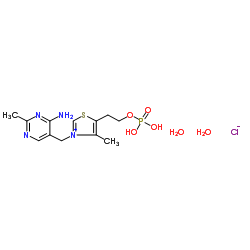Thiamine monophosphate chloride dihydrat

Thiamine monophosphate chloride dihydrat structure
|
Common Name | Thiamine monophosphate chloride dihydrat | ||
|---|---|---|---|---|
| CAS Number | 273724-21-3 | Molecular Weight | 416.818 | |
| Density | N/A | Boiling Point | N/A | |
| Molecular Formula | C12H22ClN4O6PS | Melting Point | N/A | |
| MSDS | USA | Flash Point | N/A | |
|
Chemical screening methods to identify ligands that promote protein stability, protein crystallization, and structure determination.
Proc. Natl. Acad. Sci. U. S. A. 103 , 15835-40, (2006) The 3D structures of human therapeutic targets are enabling for drug discovery. However, their purification and crystallization remain rate determining. In individual cases, ligands have been used to increase the success rate of protein purification and cryst... |
|
|
Alterations of thiamine phosphorylation and of thiamine-dependent enzymes in Alzheimer's disease.
Metab. Brain Dis. 11 , 81-88, (1996) There is a growing body of evidence to suggest that thiamine neurochemistry is disrupted in Alzheimer's Disease (AD). Studies in autopsied brain tissue from neuropathologically proven AD patients reveal significantly reduced activities of the thiamine phospha... |
|
|
Regional alterations of thiamine phosphate esters and of thiamine diphosphate-dependent enzymes in relation to function in experimental Wernicke's encephalopathy.
Neurochem. Res. 20 , 87-93, (1995) Thiamine phosphate esters (thiamine monophosphate-TMP; thiamine diphosphate-TDP and thiamine triphosphate-TTP) were measured as their thiochrome derivatives by High Performance Liquid Chromatography in the brains of pyrithiamine-treated rats at various stages... |
|
|
Vitamin B1 de novo synthesis in the human malaria parasite Plasmodium falciparum depends on external provision of 4-amino-5-hydroxymethyl-2-methylpyrimidine.
Biol. Chem. 387 , 41-51, (2006) Vitamin B1 (thiamine) is an essential cofactor for several key enzymes of carbohydrate metabolism. Mammals have to salvage this crucial nutrient from their diet to complement their deficiency of de novo synthesis. In contrast, bacteria, fungi, plants and, as ... |
|
|
Enzymes that control the thiamine diphosphate pool in plant tissues. Properties of thiamine pyrophosphokinase and thiamine-(di)phosphate phosphatase purified from Zea mays seedlings.
Plant Physiol. Biochem. 47 , 237-242, (2009) The pool of thiamine diphosphate (TDP), available for TDP-dependent enzymes involved in the major carbohydrate metabolic pathways, is controlled by two enzyme systems that act in the opposite directions. The thiamine pyrophosphokinase (TPK) activates thiamine... |